

|
Back to |
| The Front Page |
| News & Features |

|
New Victorian Centre opens to mixed reviews
|
|
by Bob Alman photos by Paddy Chapman, Max Murray, and Sue Leitinger layout by Reuben Edwards Posted January 17, 2008
|
Once the defects are repaired and professional management and marketing development expertise is in place, the new 12-court Victorian Croquet Centre can become the model facility it was intended to be - with the biggest expanse of croquet lawn in the Southern Hemisphere and a clubhouse with bar and kitchen and inside event space for up to 150. Major events produced by Croquet Victoria as well as the national association will take advantage of the abundance of courts in one location. Local and perhaps national media coverage will tout Victoria's new sporting facility with all due overtones of Aussie pride. After all that is said and done, huge and consequential questions are likely to plague the Centre for some time: How will the Victoria Croquet Association pay for this glory? How soon will the facility be financing its own future? The creators of the Centre have gone on record to respond to those questions in this article and the linked Forum on MEGA-CENTER DEVELOPMENT.
This article is a follow-up to Croquet World Online's initial story about the Victoria Centre, published in August 2006, following the completion of the clubhouse in May 2006 and shortly before the opening of three bentgrass lawns that became playable before the end of that year. That article was authored by George Latham, secretary of Croquet Victoria, moving force behind the creation of the Centre and a primary source for this article.
The new Centre and its owners -- the Victorian Croquet Association - are debt-free and in fact quite rich by croquet standards. The decision to sell for something close to $8,000,000 the old five-court Victorian Croquet Headquarters in a wealthy suburb of Melbourne resulted in spending about five million on the new 12-court facility in the Melbourne suburb of Cairnlea and using the remaining three million to create a financial portfolio to pay the bills until the Centre achieves financial self-sufficiency. The new Victorian Croquet Center is in an underdeveloped middle-class suburb of Melbourne, about a hundred kilometers southeast of the demographic center of Victorian croquet.
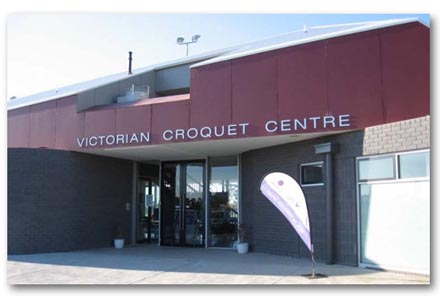
|
| The front entrance to the Victoria clubhouse is inviting and impressive compared with the typically modest croquet club. Photograph by Paddy Chapman. |
Visitors have generally reported very favorably on their experience of being at the Centre and playing croquet there, despite the roughness of the lawns - to be considerably upgraded in early 2008. All the correspondents - without exception - requested anonymity, giving various reasons why it would be "inappropriate" or "unwise" for them to comment for publication. The irony is that several glowingly positive word-portraits of the experience of playing at Cairnlea cannot be published here, because we do not publish quotes without attribution as a matter of policy. (Perhaps such an account will be self-posted in our linked Forum.)
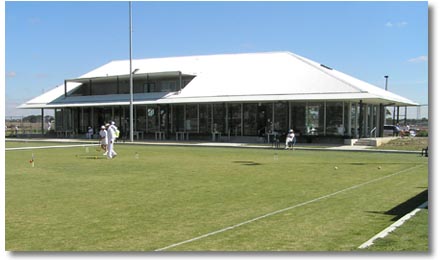
|
| Looking north showing the views spectators can get from the comfort of the clubhouse. Photograph by Murray. |
Getting the Centre built was difficult enough, and correcting the defects will take time - but there's nothing exceptional in that. All newly designed buildings are expected to have defects that will be routinely corrected. The main challenge of the Centre will be to manage it to the point of financial self-sufficiency by 2010, as promised by George Latham, who spearheaded the project from its inception seven years ago.
The author has been defeated
This writer must now confess to defeat in confronting the task of writing a complete, fair, balanced, and honest follow-up article on the Victorian Centre.
Even though we have no space limitations in this medium, the story is too big to see at one sitting, too multidimensional to grasp all at once. It embraces nearly every aspect of the sport in Australia and internationally. We are fortunate to have 25 photographs of the facility to grace this article. But the "big picture" must remain unfocused for the present. Read on to find out why.
The president of Croquet Victoria, Valerie Brown, in partial response to our questions about the Centre and its financial future, has objected to the term "megacentre" as "over the top." She reminded us, "The VCC was erected as the Victorian State Headquarters, not a big croquet club." The intention, she said, was "to lift the concept of our game to its proper position, that of a progressive and functioning sport...where people could look at our Headquarters with respect."
What makes a megacenter?
"Megacenter" is a journalistic expedient invented by this writer to characterize a dedicated croquet facility which is, however, built on such a scale that it must be subsidized to a significant degree by non-member-related revenues. There are two such Centers in the world - in Florida and now in Victoria - and their survival and success (as measured by financial viability) can be viewed as vitally important to the future development of the sport. If they succeed, they will be effective models not just for croquet organizations but also by private entrepreneurs and developers who will grasp the profit potential for creating a meeting and conference center (for example) surrounded by croquet lawns to give their event business a special edge with a croquet amenity - and which also can host a large and profitable local croquet and social club. Add some condos and a gatekeeper, and you'll have "a croquet community." at much smaller cost than the standard "golf and country club" residential developments.
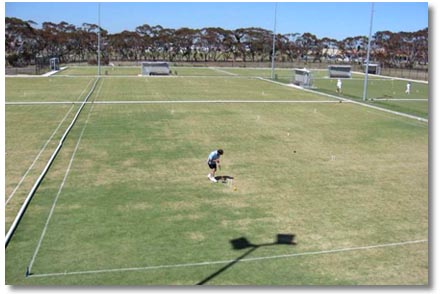
|
Croquet's two megacenters share a significant point of origin, each beginning with the determined intention of a strong personality with his hands on the purse strings of a multi-million-dollar bankroll to create a facility capable of spearheading a new era of development in the sport; and each ending with the actual creation of a 12-court facility straining towards financial self-sufficiency.
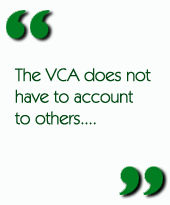
Whether and how these two megacenters succeed is a matter of great interest to croquet players and organizers everywhere. But in response to pointed questions about how the Victoria facility is to be managed to succeed, croquet officialdom in Victoria are apt to respond in this way, like Valerie Brown: "The Association has Directors who are thoughtful and make considered decisions, a Committee of Management who are committed to conducting the running of the everyday dealings of the Association in a proper and business like way and who realize that the time has come for professionals to be in place to administer, do greenkeeping etc."
To put it succinctly, President Valerie Brown has said in response to questions related to quantities and timelines, "I consider that the VCA [Victorian Croquet Association] does not have to account to others in the way the business is conducted, as proper care is being taken."
This is absolutely true. No one is required to answer the pointed questions of any journalist - who may, however, continue to pursue the story in spite of a dearth of relevant facts from primary sources.
Bridging the gulf between the amateur and the professional
The presidential rebuff points to what may be the most compelling unanswered question: Is it possible for these two megacenters to succeed financially - maybe even flourish - if the management authority resides in bodies of amateur, part-time volunteers from the croquet world acting through voting committees and nonprofit corporate boards, largely unaccustomed to operating on professional business principles, and accountable, as a practical matter, to no one, including the members of its own association? That question remains to be answered, for both centers.
But a broad view of sporting history tells you that the question can be answered YES! The essential shift from amateur to professional has ample precedent. Such an organizational "sea change" has actually happened over the last century in other sports, notably golf and tennis. More than 135 years ago, it might have happened with croquet at Wimbledon....but something went terribly awry, and there are still lessons to be learned from Wimbledon's failure as croquet's first celebrated "megacenter." (See David Drazin's "How we lost Wimbledon.")
Although Wimbledon was without question a state-of-the-art facility for the new game in the 1870's, the extreme refinement of its lawns, equipment, and advanced "laws of the game" helped to alienated the sport from its popular base, the people who loved "grass-roots" croquet as a casual social pastime - the same kind of people, arguably, who prefer Golf Croquet today to the more serious Association variety.
Centre's finances secured by multi-million-dollar investment portfolio
Unlike the National Croquet Center in Florida, the Victorian Croquet Centre has opened with an abundance of funds sufficient to support operations for many years to come, regardless of the amount of revenue the facility is able to generate.
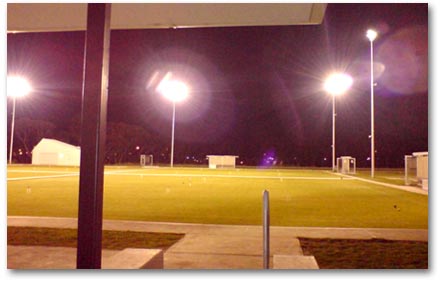
|
| Night lighting on four of the courts is one of the chief distinctions of the Victoria Croquet Center. This photo shot from near the clubhouse during the doubles final of the 2007 Australian Opens shows, by the uneven distribution of light on the courts, why night lighting is not favored by serious players. For social croquet - for private parties and corporate events - night lighting could be a significant element in raising revenue to help support the facility's maintenance. Photograph by Paddy Chapman. |
According to the Victoria Croquet Association Council meeting minutes from December 13, 2007, "$300,000 from the investment portfolio has been set aside to underwrite the salary of the sports administrator and the shortfall in the running of the VCC over at least the next three years." George Latham has told Croquet World in his FORUM article that only two years are required for the Centre to break even financially.
Various financial figures have been quoted, but no comprehensive picture has been drawn for us of total expected expenses and revenues. Instead, general statements have been made which, on closer examination, do not add up to produce the desired quantities.
An estimate close to $180,000 in annual expenses is quoted in minutes of a recent VCA Council meeting, but that figure does not include salaries, fees, and unforeseen expenses - including the huge unknown with respect to securing water for the lawns in a drought-prone region now experiencing one of the most severe and prolonged droughts on record.
Salaries and professional fees could be a huge expense
Paid staffing for the Center already includes a Sports Administration Officer, Sandra Kastanara, and a live-in caretaker couple, John and Gisela Irlam, who, according to the new Victoria website, "will organise all activities at the Centre and will take bookings for all activities and functions at the Centre if Sandra is not available." A full-time greenskeeper is to be hired soon to oversee the upgrades necessary to improve the substandard greensward and maintain the 12 courts to a respectable playing standard.
Given all these unavoidable costs, total annual expenses of less than $300,000 can scarcely be imagined by this writer, and this is an optimistic estimate, based on business plan drafts and other documents from VCA Council meetings. Reviewing these fragments and references, it's no wonder that a single, clearly articulated Business Plan has not yet been put forward, backed by a comprehensive, integrated Marketing and Development Plan to maximize revenue streams from every possible source.
Comparisons with the Florida Center
It takes considerably more than $600,000 a year to run the National Croquet Center in Florida, according to the president of the Croquet Foundation of America, owners of the facility. After five years of operation, the Florida Center has not yet achieved break-even, despite annual income of close to $300,000 from club memberships, lawn rentals, and other lawn-based events, and more than $300,000 from function rentals.
Based on half a decade's experience in trying out many different approaches to membership and business development at the Florida Center, a broad official consensus has emerged. There is general agreement that the event revenue has now been optimized, and the only place to look for break-even numbers is in membership fees: There must be more members, and ultimately, the fees have to be higher than they presently are, ranging from $500 to $1500 a year, depending on membership type.
By contrast, the Victorians see no revenue potential in developing a large club at their megacenter; and there's not much function space to be sold.
The Victoria Centre's inside function space seats 150 theatre-style and 100 for dining - a fraction of the function space at the Florida Center, which accommodates more people in its upstairs ballroom alone. Moreover, the rentable space of the Victoria Centre, though sleek and clean and augmented by kitchen and bar amenities, is pedestrian compared with the elegant architecture and Edwardian era furnishings of the Florida Center.
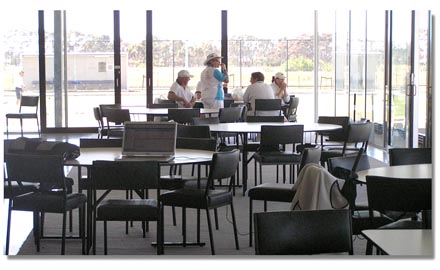
|
Most tellingly, the Florida Center is situated in one of the richest counties in the US, a favorite venue for charity balls for glitzy causes and corporate conventioneers who will pay top dollar for elegant dining venues and chic lawn parties with Golf Croquet. No such market exists at Cairnlea.
As someone who organized and managed the National Croquet Center club for its first 2 1/2 years, it's difficult for this writer to imagine, even with brilliant scheduling and management, that the Victoria Centre can generate as much as $100,000 a year in function space rentals in the near term.
Just for perspective, consider this: A one-day "buy-out" of the Florida Center costs $5,000. Rental of the public spaces of the Victoria Centre costs $350.00 a day. Rent the Victoria Centre for 272 days of the year, and you'll come up with $100,000. But that doesn't include the maintenance and other costs to the landlord, and it doesn't account for the numerous croquet events that need the same space.
Comparisons of these two facilities, on opposite sides of the globe, and operating in starkly constrasting physical and cultural settings, will be properly seen as odious. Nevertheless, the Florida Center has set the standard for producing multiple revenue streams to pay for maintaining a large croquet club, and many of those streams - pro shop sales of equipment and clothing, expensive social memberships, and profit-making lawn rentals to nearby croquet clubs for their big tournaments - appear not to be accessible to the Victoria Centre's managers.
The bottom line is red; the winning formula has yet to be discovered
With annual expenses estimated conservatively at $300,000 and likely revenues of less than $100,000, this leaves a deficit of $200,000 a year, twice the $100,000 a year provided for in the three-year "shortfall" funding plan recently voted by the Victorian Croquet Council.
If the organizers knew how the Victoria Centre can create the financial self-sufficiency that the Victorian Croquet Council has pledged to achieve in order to ensure that the investment portfolio can be used to support and promote croquet in all the 93 clubs and 13 regional associations of Victoria, surely they would tell us. It's reasonable to assume that they don't know.
Just as surely, observant managers can learn a lot from trial and error about marketing the Centre in the first year or two of "full operation." Valerie Brown indicated as much when she wrote, "As with all new things it takes time for everything to fall into place It is happening - the VCC is a success and will continue to be."

But when you start at zero, everything is up instead of down, everything is more instead of less. It's the boast every new organization makes, and it works only briefly, in the beginning. It works until somebody starts asking "How high is up?" "How much is more?" "Exactly when is soon?" The essential quantities are in short supply in the voluminous official reports of the Victoria Croquet Association. The club is "growing," but it has only about a dozen members. Event sales are "increasing," but how much revenue can actually be provided by a clean and well-lighted but mostly undistinguished event space for a maximum of 100 seated diners? Major Australian croquet events can and will be held with increasing frequency at the Centre as the defects in the lawns and the facility are corrected - but with the ACA setting the upper limit for lawn rentals at $15/day per lawn, how can that help the Centre's bottom line?
On the other hand, it's quite possible - even likely - that with good professional management and marketing expertise the Centre could generate significant new revenue streams by reaching into the community not just to sell function space, but also to develop a new, fun-loving and casual image for a more youthful demographic by promoting "malletsports," using the Centre to anchor the kind of outreach that could bolster sagging club membership throughout the region and the continent.
If "How?" is the question, could "Malletsports" be the answer?
One of the most promising developments in marketing and promoting croquet is the new official emphasis in Australia on "malletsports" - embracing the fun and variety of every game that uses mallets - including Golf Croquet and Gateball, a space-efficient mallet game played on small courts by five-person teams. The Australian Croquet Association [ACA} has undertaken the stewardship of the game in Australia, and the 2007 National Gateball Championship was one of the first major events of the 2007-08 season at the new Centre.
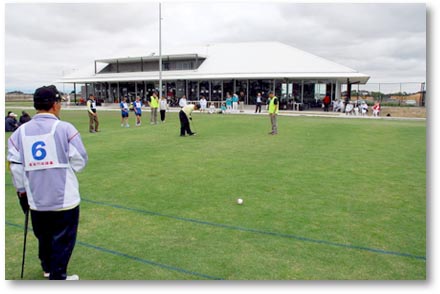
|
| The National Gateball Championship in December '07 demonstrates the potential of promoting not just Association Croquet at the big facility, but all "malletsports." Here the Wombats of Australia's Brunswick Malletsports Club take on the Japan team. Photograph by Sue Leitinger. |
These progressive ideas look good on paper, but they are often shot down by seasoned players who disdain "inferior games" and oppose use of their facilities for activities that degrade the sport. This attitudes hampers the progressives in many croquet associations, not just in Victoria or in Australia, who believe the sport can be revitalized by including simpler and easier to play forms of the game in their programs and attracting a broader and more youthful demographic to croquet. The Australians, to their credit, have done more than any other country to provide sustained organizational support for the "malletsports" concept to repair the sport's public image and expand its public appeal.
The federal structure of Australian croquet called into question
The travails of the Victoria Centre have surfaced mostly through the apparent attempted suppression of internal dissent through various means by heavy-handed management with small regard for conventional notions of sound public relations. The publicity given to some of these actions appears to have played a part in igniting a tentative revolution in Australian croquet spear-headed by the prominent playing couple Liz and Bruce Fleming. Liz Fleming is a top-ranked Australian player who has become a lightning rod of dissenting opinion on a wide range of issues, while her husband Bruce Fleming - another Aussie champion - has annouced his candidacy for the vice-presidency of the ACA, partnered with Bruce Mitchell, a former Executive Director of the ACA seeking the presidency, to be voted in April of 2008.
The relatively closed system of government in Australian croquet has been handed down from the ancient roots of the sport's establishment Down Under through separate organizations in each of the Australian states more than a century ago, separated by vast distances now easily bridged in transport and instant communications. Australian croquet's strong local "grass roots" persist, even as the national organization tries to tie the continent together in common purpose with standardized policies on coaching, team selection, and national competition, with a national publication representing national consensus.
The national organization - the ACA - is a loose federation of six state associations, at best. The real power still resides in the states. (Almost 2,000 of the 6,000 associated croquet players in Australia live in Victoria.) One effect has been to disenfranchise associated members who would like to have a voice in national affairs, because every approach to national concerns has to go through the state associations and be approved by the state councils, including election of national officers and changes in the ACA constitution. As all croquet is local, the state associations have near-absolute power over the players. They need answer to no one.
The other state associations, fiercely independent and self-determined, have been scrupulously neutral with regard to the Victoria Centre, expressing concerns that the 12-court centre and clubhouse will draw away from their states the national events that have historically moved around from state to state in rotation. This has been strongly and consistently denied by both state and national officials. But although the players of the 2007 Australia Open Championships voted overwhelming to continue to rotate the championships, the event has been scheduled for the Victoria Centre again in 2008, in apparent contradiction to both the official denials and the voted wishes of the players.
In the meantime, for the foreseeable future, as two megacenters on opposite sides of the globe continue to grope their way down separate, uncertain paths towards financial self-sufficiency, they represent, together, the farthest advance of the sport of croquet towards the mainstream. When the lawns of Victoria Centre are improved - as they inevitably will be, and soon - both centers will offer superb settings for the enjoyment of the sport at its best.
Croquet World will continue to report this story until both megacenters are flourishing in the black. Readers are invited to help us report the story for the long term, through the linked Forum on Mega-Center Development.
|
See the Forum on Mega-Center Development for source documents, articles, and reader response
The linked self-posting Forum on MEGA-CENTER DEVELOPMENT contains detailed source documents on this article, and you can add to it by directly posting your own items of related information or opinion. The articles in the FORUM include an extensive Victoria Centre year-end update by George Latham, secretary of Croquet Victoria; and a joint letter to Croquet World Online Magazine from John Fransen, president of the Australian Croquet Association; and Val Brown, president of the Victorian Croquet Association. All these documents and articles will stay online indefinitely, linked to Croquet World's continuing coverage of the development of the largest and most significant facilities in our sport. The editors can thus ensure the continuing currency of the material and guarantee access to all points of view, indefinitely. We invite a full range of fact, observation, analysis and informed opinion. The editors, while inviting all responsible input, will actively monitor the communications to the Forum, and we request well-considered and temperate contributions on an issue that has become increasingly contentious and volatile. |